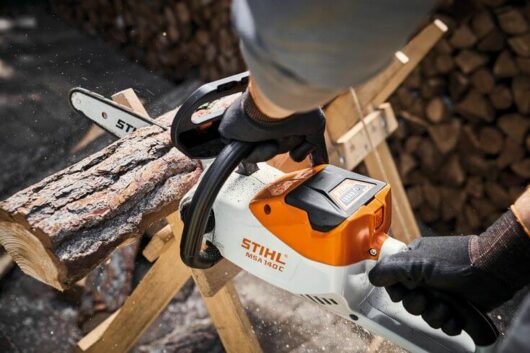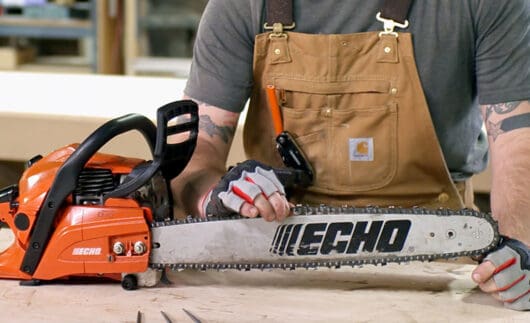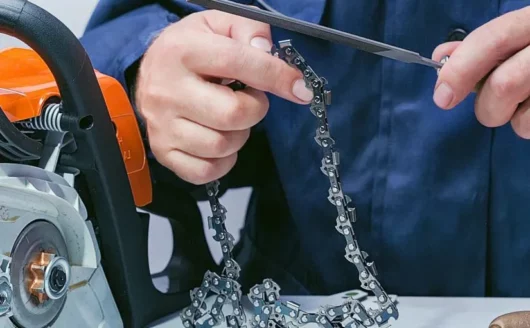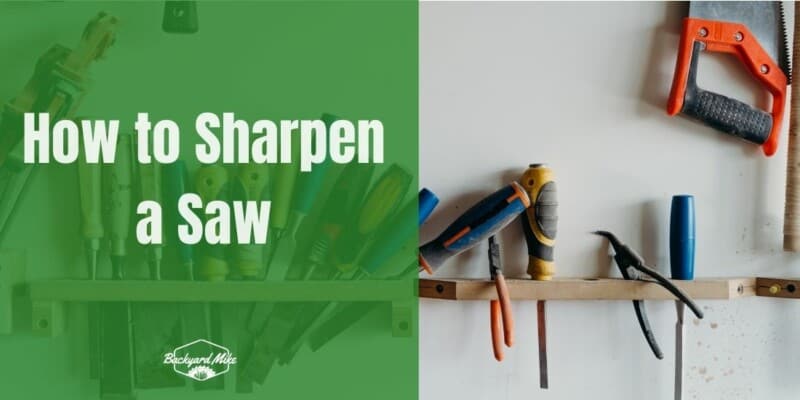Welcome to the world of DIY! If you’re looking to sharpen a saw, you’ve come to the right place. This article will provide you with a step-by-step guide to sharpening saw teeth, so you can get the job done quickly and easily. So, get your tools ready and let’s get started!
Overview of sharpening a chainsaw
The advancement of cutting tools from the axe to the chainsaw may be one of the biggest evolutionary leaps in the history of outdoor power tools. Overnight, the task of felling a tree went from incredibly laborious, time-consuming tasks to something that was effortless and amazingly quick that can be carried out within hours. Today, chainsaws are commonly used by both professionals and DIY-ers to cut down trees and branches. However, even the largest and most powerful chainsaws cannot cut with a dull chainsaw chain.
Like any other tool, a chainsaw needs to be properly and consistently maintained to perform effectively. Of course, you can always hire a professional for sharpening your chainsaw. However, most DIY-ers can easily learn the right way to sharpen to handle the job on their own and save money during this process. Luckily, unlike most power-cutting tools, you’ll be able to easily sharpen a chainsaw and get it into a brand-new condition within a matter of minutes.
If you’re noticing that your chainsaw is no longer cutting as easily and as cleanly as it once used to, it’ll be smart to learn how to sharpen your chainsaw blade and check for dull or sharpened teeth. A sharp chain needs to cut quickly and in a straight line. A properly-sharpened chainsaw will help prolong the life of your chainsaw’s guide bar, engine, sprocket, and other components by reducing wear.
A dull chainsaw will definitely be a dangerous chainsaw. Needing to force the cuts will put a strain on both the chainsaw and the user. It’ll increase the possibility of injuries as the performance levels and the ability to cut will be reduced. This could cause the operator to use force for manipulating the machine. You should make sure that you’re referring to the owner’s manual for the right chainsaw sharpness and lubricants. While going through the owner’s manual and adhering to the safety protocols is advised, it is also important that you familiarize yourself with the proper handling and usage of the chainsaw.

Tools and equipment to gather before sharpening the chainsaw
A chainsaw is a powerful and essential tool for both professionals and homeowners alike. But like every other tool, a chainsaw will also require maintenance to ensure safety and longevity. One important aspect of maintaining a chainsaw will be sharpening the chain. Sharpening a chainsaw will be an important part of maintaining the chainsaw’s efficiency and safety. One of the most important parts of sharpening the chainsaw will be to use the right tools.
Before you reach the actual part of sharpening, it’ll be important to carry out the preparation part. There are many tools and equipment that you’ll need to arrange before you start sharpening. Here are some of the tools that you will require –
#1. Type of saw blades
When it comes to sharpening the chainsaw, there are two types of saw blades – round and flat. Round saw blades are used for sharpening the chainsaw’s cutting teeth, whereas flat saw blades are used for filing the depth gauges. The cutting teeth are the small point teeth responsible for cutting through the wood, whereas the depth gauges are the small bumps on the chain that controls how deep the teeth are cutting.
#2. Honing rods
Honing rods are another important tool needed for sharpening the chainsaw. These rods are used for maintaining the edges of the chainsaw’s cutting teeth. Honing rods come in different sizes and shapes, but the most common one is the cylindrical rod. These rods are made using hardened steel and are designed to run along the edge of the cutting teeth. When carried out correctly, honing rods can help in keeping the cutting teeth sharp and improve the chainsaw’s overall cutting performance.
#3. Clean cloth
A clean cloth is a necessary tool when it comes to sharpening the chainsaw. After filing the cutting teeth and the depth gauges, it’ll be important to remove any debris or metal filings from the chain and the chainsaw blade. A clean cloth can be used for wiping away any debris and making sure that the chainsaw is clean before using it again.
#4. Chainsaw file guide
A chainsaw file guide is an important tool for sharpening the chainsaw chain. This guide is used for holding the chainsaw file at the appropriate angle while sharpening the chain’s teeth. The angle of the file gauge will depend on the chainsaw’s chain, so it’ll be important to select a guide that matches the chainsaw chain’s pitch.
#5. Chainsaw files
Chainsaw files are small, pointy tools that can be used for sharpening the chainsaw’s teeth. They come in different sizes, and it is important to use the correct file size for the chain that you’re sharpening. The diameters of the file must match the diameter of the teeth, and the pitch of the file must match the pitch of the chain.
#6. Depth gauge tool
The depth gauge tool is used for maintaining the height of the depth gauges, and it controls how deep the chainsaw teeth can cut. This tool is used for filing down the depth gauges to the correct height, which makes sure that the chain cuts the wood safely and efficiently.
#7. Safety gear
Safety gear is important when sharpening the chainsaw. Gloves and eye protection are essential for protecting the user against flying debris, Meanwhile, a face shield should also be used for extra protection. Additionally, ear protection is also recommended for protection against the chainsaw’s noise.
Preparations to carry out before sharpening the chainsaw
Sharpening the chainsaw chain is an important part of maintaining the chainsaw’s efficiency and safety. However, before you start with the actual sharpening process, there are certain steps and preparations that you will need to carry out to make sure that your chainsaw is ready for sharpening. Here are the important steps that you will need to follow –

#1. Identify the chainsaw teeth
The first step that you will need to follow when preparing to sharpen your chainsaw is identifying the chainsaw teeth. The saw teeth are the small, pointed teeth on the chainsaw that are responsible for cutting through wood. For identifying the saw teeth, you must carefully examine the chainsaw chain and look for the small, pointed teeth. It is important that you should make sure that you have successfully identified all the saw teeth before you proceed with the sharpening process.
#2. Remove the dirt and debris
Before you sharpen the chainsaw, it will be important to remove any dirt and debris from your chainsaw chain and saw blade. This is important because dirt and debris can often affect the chainsaw’s performance and accuracy during the sharpening process. You can make use of a wire brush or compressed air for removing any dirt and debris from the chainsaw chain and saw blade.
#3. Choose the right honing rod
Choosing the right honing rod will be important when preparing to sharpen your chainsaw. Honing rods come in different shapes and sizes, and it is important that you must choose the honing rod that matches the shape and size of the saw teeth in your chainsaw. The most common type of honing rod is the cylindrical rod, which is used for maintaining the edges of the chainsaw’s cutting teeth. It is important that you select a honing rod that is made using high-quality steel and has a diameter that matches the size of your saw teeth.
How to sharpen a saw?
Sharpening the chainsaw chain is an important yet simple part of maintaining its efficiency and ensuring that it operates safely. After you have identified the chainsaw teeth, removed any dirt and debris, and chosen the right honing rod, it’ll be time to begin with the sharpening. Here are the steps that you will need to follow for the actual sharpening part of the sharpening process –
#1. Position the honing rod
To position the honing rod properly, you will have to hold it at a 90-degree angle to the chainsaw teeth. The honing rod must be positioned such that it is resting on the depth gauge and not the cutting tooth. The depth gauge is essentially the small metal tab in front of each cutting tooth and it is important that you do not sharpen it.
#2. Apply pressure and move the rod
When you are applying pressure to the honing rod, make use of a light touch. Too much pressure could end up damaging the cutting tooth and shorten its lifespan. Moving the honing rod in a circular motion, you will need to work on each cutting tooth for a few seconds. It is important that you are maintaining a consistent angle and pressure throughout the sharpening process.
#3. Stroke the teeth at a particular angle
You’ll have to set the file into the notched section of your chainsaw located at the head of the cutting tooth. Hold the file at an angle, the same angle at which the notch was ground initially or filed most recently. Slide the file across the cutting teeth and twist it so that it creates friction as you are stroking. You can reference the chainsaw sharpening angle chart to determine the proper angle. From the initial cutter, you should file every second cutter around the chain.
#4. Sharpen the other side of your chainsaw chain
Now, you will have to reverse the chainsaw and proceed to file each of the teeth that you previously left alone during the first round of sharpening. Once you are finished, the flat tops of the cutters need to be more or less precisely of the same length.
#5. Check the depth gauges
Then, you will need to inspect the depth gauges (the curved links between the cutters). Each depth gauge or raker must be shorter than the adjacent cutter. If you’ve got a depth gauge that has a height exceeding its closest cutter, you must file down the raker such that it sits around 1/10 inch below the height of the cutter counterpart.
#6. Polish the teeth
Once you have sharpened each cutting tooth, make use of a clean cloth for polishing the tooth. This will help you remove any small burrs or rough edges that might have been left after the sharpening. Polishing the teeth also helps in improving the chainsaw’s cutting performance and reduces any wear on the chainsaw chain.
#7. Check the results
After you have finished sharpening the chainsaw, it will be important to check the results. Hold the chainsaw to a light source and examine the teeth. They must all be of the same length and shape. If any tooth appears shorter or has a different shape than others, you will need to re-shape it.
How to maintain the chainsaw after sharpening?
Maintaining a chainsaw is critical to its efficiency and longevity. As important as sharpening is for the performance of your chainsaw, maintaining it after sharpening will be equally important. Here are some of the tips to keep in mind when it comes to maintaining your chainsaw after sharpening –
#1. Clean the chainsaw regularly
One of the most significant aspects of chainsaw maintenance will be regular cleaning. After every use, you must wipe down your chainsaw’s exterior with a clean cloth to remove any dirt or debris that might have accumulated. You should ensure that you’re removing the chain and cleaning it separately. Use a small brush for removing debris from the chain, bar, and sprocket. Moreover, check the air filter and clean it or replace it if needed.
#2. Store the chainsaw properly
Storing your chainsaw properly can help extend the lifespan of your chainsaw. When it isn’t in use, you must store it in a dry and cool location, away from any direct sunlight or extreme temperatures, as it might cause the plastic parts to deteriorate over time. Make sure that you’re protecting your saw against any dust, moisture, and other elements that can potentially be harmful to your chainsaw. You should ensure that the chainsaw is completely dry before you store it, and cover it using a protective sheath or case. Moreover, you should make sure that you’re draining the fuel and oil tanks before you store the chainsaw for an extended period.
#3. Replace the blades
Over time, the blades of your chainsaw can become dull or damaged, and this can affect the performance and efficiency of your chainsaw. Blade replacement will be an important aspect of chainsaw maintenance. You must inspect the chain for any signs of wear or damage, such as broken teeth, and replace them if necessary. Moreover, inspect the bar for any signs of wear and replace it if it appears to be bent or damaged. To replace the blades, you will need to remove the old bar and chain and install the new one as per the manufacturer’s instructions. You should also check the chain’s tension periodically and adjust it when necessary.
#4. Other tips
Aside from regular cleaning, proper storage, and blade replacement, there are some other tips that you should remember when maintaining the chainsaw. Always make use of fresh gas and oil mixtures and avoid using old or contaminated fuel. Keep the chain’s teeth sharp and lubricated to make sure you’re getting an optimal cutting performance. Check the chain’s teeth regularly for any wear and replace the chain if teeth are damaged or worn down. Lastly, make sure that you’re following the manufacturer’s instructions for your chainsaw model.
Tips to remember when sharpening your chainsaw
Sharpening the chainsaw is an important task that can greatly improve the performance and lifespan of your chainsaw. However, it can also be somewhat dangerous and challenging if you don’t do it properly. Here are some of the tips you need to keep in mind when you are sharpening your chainsaw –

#1. Wear protective gear
Before you start sharpening your chainsaw, you should ensure that you’re wearing the appropriate safety gear. This includes gloves, ear protection, eye protection, chainsaw chaps, and more. Chainsaws are extremely powerful tools that create flying debris, and the noise can potentially damage your hearing or result in injuries if not careful.
#2. Identify the teeth
A key tip that you must remember when sharpening the chainsaw is to first identify the teeth. The teeth will be the pointed edges that cut through wood. Typically, there are two types of teeth on a chainsaw – cutting teeth and depth gauge teeth. Cutting teeth are the teeth that cut through the wood whereas the depth gauge teeth set the depth of the cut.
#3. Use the same number of strokes
If your chainsaw pulls to the side when cutting, it is happening because the cutters on that side are slightly sharper than the ones on the other side. To make sure the chainsaw is cutting in straight lines, you must file every tooth with the same number of strokes. Moreover, you should be doing this under the same amount of pressure.
#4. Buy multiple chains and switch them occasionally
If you’ve been using the same chain for a few years, you will have to purchase a new one. Initially, the new chain will not mesh smoothly with the bar and sprocket. It will result in faster wear on the chainsaw and give rougher cutting. You can purchase two extra chains and switch among the three occasionally. This way, the components of the cutting train – chain, bar, and sprockets will fit together and prolong the lifespan of the chainsaw.
#5. Use file guides to file at the same angle
Using file guides that clamp to the chainsaw bar will ensure that you’re filing the same angle on each cutter. They may take a little longer to use but they’ll restore the cutting edge to the factory-ground angle. This way, there will be a lesser chance that you’ll be required to have the chain reground by a professional.
FAQs
What are the steps to sharpen a saw?
Sharpening a saw requires several steps, including cleaning the saw blade, setting the angle of the teeth, sharpening the saw blade, filing the teeth, and setting the depth of the teeth. Cleaning the saw blade requires a brush or wire brush and cleaning solution, while the angle and depth of the teeth should be checked with a protractor and depth gauge. Sharpening the saw blade requires a file and should be done in one direction with even strokes. Finally, filing the teeth requires a triangle file and involves filing each tooth in a single direction
What tools are needed to sharpen a saw?
The tools needed to sharpen a saw include a brush or wire brush, cleaning solution, protractor and depth gauge, file, and triangle file. Additionally, it is important to have safety equipment such as safety glasses, gloves, and a face mask when sharpening a saw.
How can I tell if my saw is sharp enough?
You can tell if your saw is sharp enough by cutting a piece of wood and examining the cut. If the saw leaves a smooth, clean cut without any splinters or chipping, then the saw is sharp enough. However, if the cut is rough or the saw is having difficulty cutting through the wood, then the saw may need to be sharpened.


